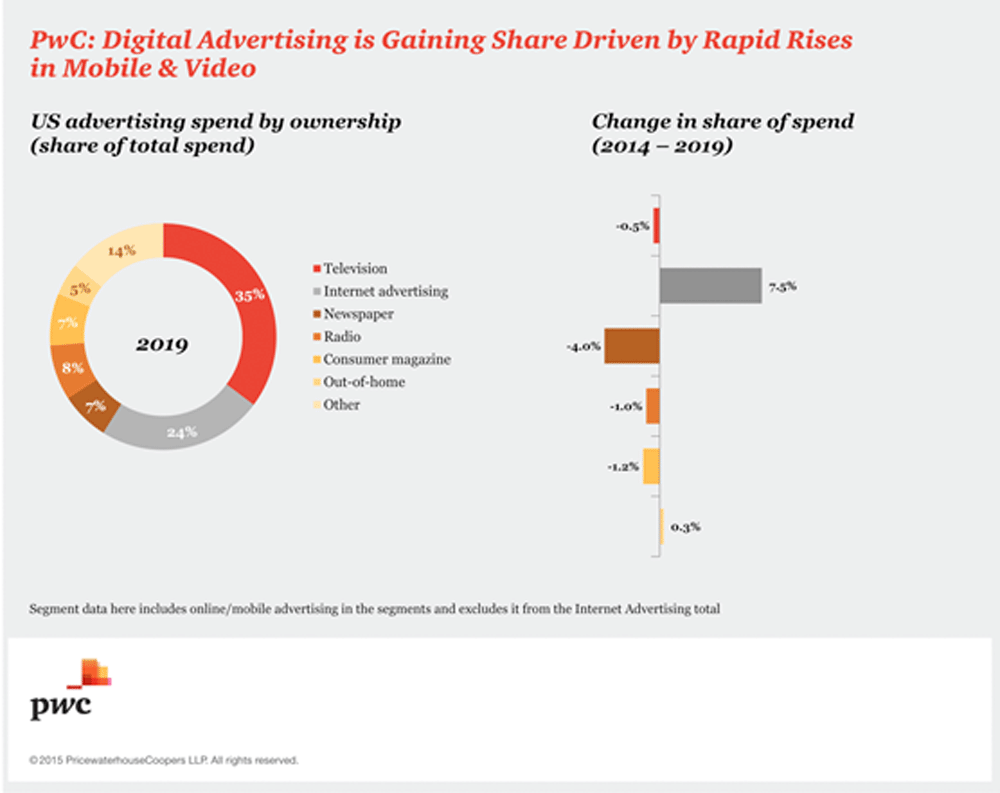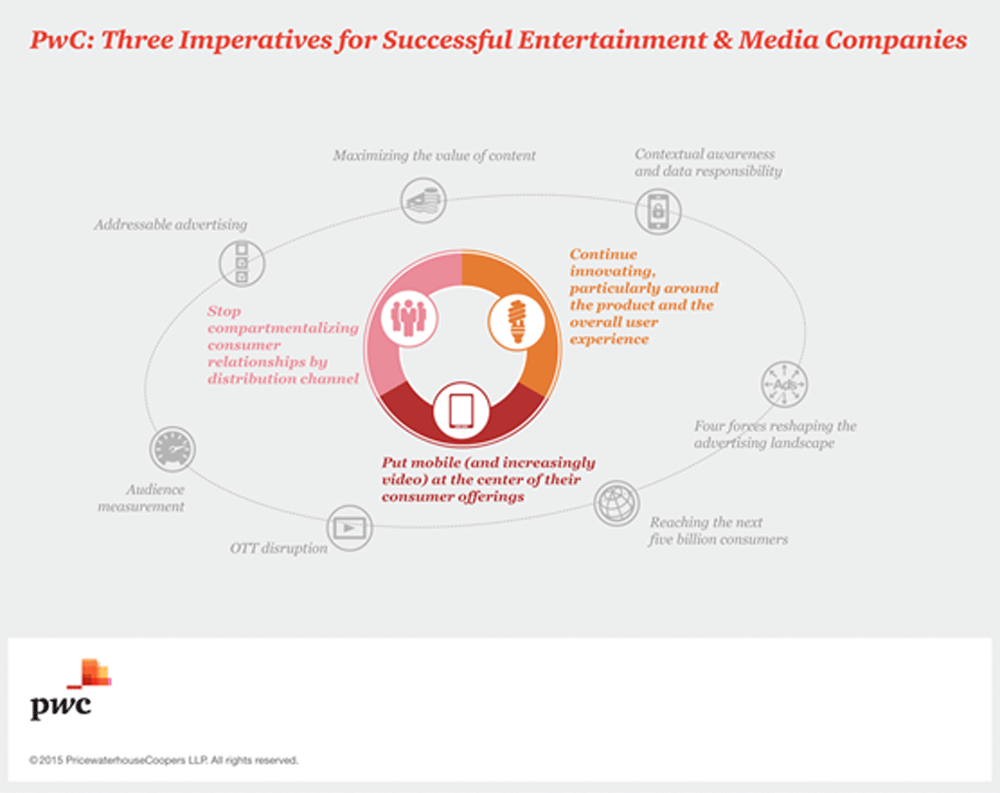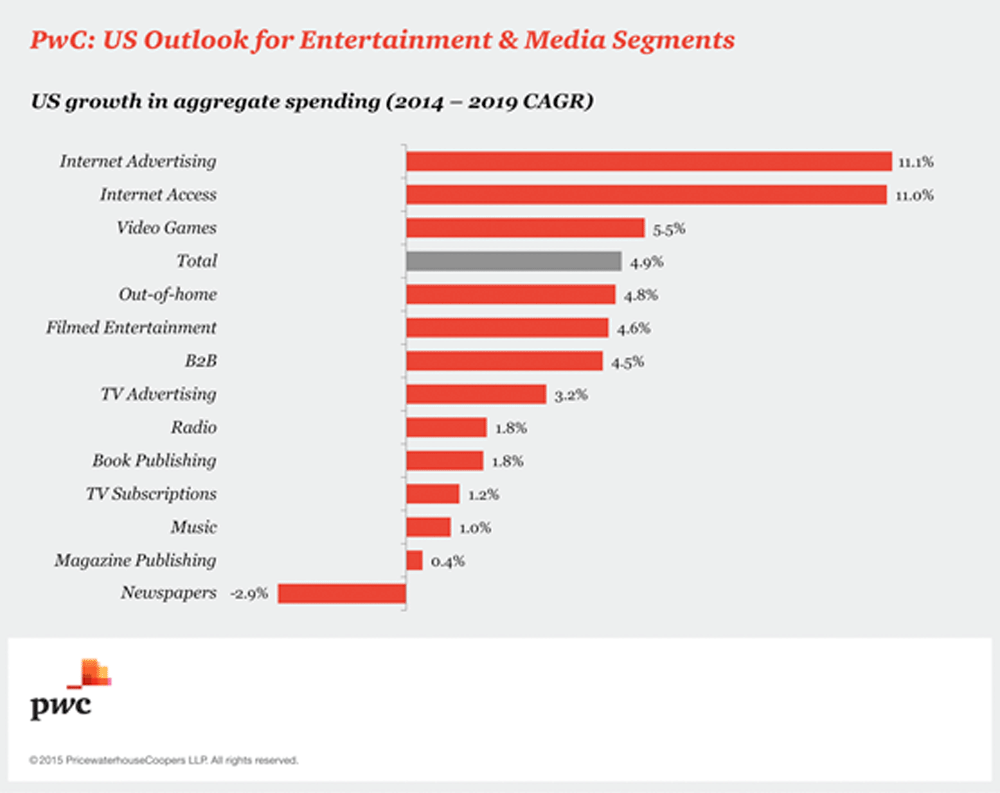The Digital and Traditional Media Divide is Irrelevant Among Consumers [INSIGHT]
June 4, 2015
 After more than a decade of digital disruption across the entertainment & media (E&M) industry, the distinction between digital and traditional media is deemed irrelevant in the minds and wallets of consumers, according to PwC’s annual Global Entertainment and Media Outlook 2015-2019. The E&M industry is now a multifaceted ecosystem – with new digital offerings creating a bigger, more diverse content universe and with digital accelerating delivery across platforms – whereby consumer choice is paramount.
After more than a decade of digital disruption across the entertainment & media (E&M) industry, the distinction between digital and traditional media is deemed irrelevant in the minds and wallets of consumers, according to PwC’s annual Global Entertainment and Media Outlook 2015-2019. The E&M industry is now a multifaceted ecosystem – with new digital offerings creating a bigger, more diverse content universe and with digital accelerating delivery across platforms – whereby consumer choice is paramount.
The Outlook forecasts that global E&M spending is expected to rise from $1.74 trillion in 2014 to $2.23 trillion by 2019, growing at a compound annual growth rate (CAGR) of 5.1 percent. The U.S. remains the largest E&M market, growing at a 4.9 percent CAGR and reaching $723 billion by 2019, from $568 billion in 2014.
While global revenue from digital media is expected to generate stronger growth, non-digital media is still projected to be the significant contributor of global consumer revenues in 2019. A key takeaway of this multifaceted environment is the resilience – and in some cases resurgence – of some traditional media, including the shared, live experiences that consumers still love. In the U.S., spending on live music ticket sales (4.4. percent CAGR) and cinema box office (4 percent CAGR) is expected to outpace overall U.S. consumer spending at 2.9 percent by 2019. U.S. digital spending is expected to grow at 11.1 percent CAGR over the next five years and account for 46 percent of overall U.S. E&M spending growth, up from 34 percent in 2014.
“In today’s multi-platform environment, E&M companies must take a hard look at the talent, organizational structure and alignment of performance measures with overall strategy across their entire business,” said Deborah Bothun, PwC’s U.S. entertainment, media & communications leader. “While this may seem self-evident, it remains a major challenge that many companies are struggling to overcome as they transform their operations to engage today’s consumer. Mastering the user experience will be the critical success factor for monetizing consumers and sustaining growth.”
Advertising – Mobile and video driving digital growth
U.S. advertising revenues are forecasted to rise at a CAGR of 3.5 percent, increasing from $193.8 billion in 2014 to $230 billion in 2019. In the U.S., Internet and video games advertising, both forecasted to grow at 11.1 percent CAGR, is expected to continue to dominate the growth landscape. Furthermore, Internet advertising is projected to overtake U.S broadcast TV advertising (2.5 percent CAGR) in 2018. Digital advertising is gaining share from all segments with rapid rises in mobile and video Internet advertising. U.S. mobile Internet advertising will likely surge at a 25.6 percent CAGR in 2019, which overtook U.S. display Internet advertising in 2014, and will supplant paid search in the U.S. in 2016 as the leading Internet advertising category. Video advertising spend in the U.S. is projected to rise at a CAGR of 15 percent.
The rise of over-the-top (OTT) video services is further changing advertising. As viewers migrate from traditional networks to digital alternatives, advertisers will follow, driving broadcast TV advertising’s share of U.S. total TV advertising down from 95 percent in 2014 to 91.6 percent in 2019.
In the U.S., digital out-of-home advertising (DOOH) is another high-growth area projected by Outlook, with revenues expected to rise at a 9.8 percent CAGR. Given the high costs of upgrading OOH to digital formats, the most lucrative markets for DOOH advertising will be major cities.
“Amidst the proliferation of content and access options, it’s clear that consumers are demanding more flexibility, freedom and convenience regarding when and how they consume content,” said Joe Atkinson, PwC’s U.S. advisory entertainment, media & communications leader. “They want it on-demand, on mobile and are readily engaging with content experiences that they can’t get elsewhere. This has re-energized the enduring appeal of shared, real-life experiences, such as cinema and live sport and music events, which has survived during the growth of digital. In creating new offerings, E&M businesses will need to consider attributes that combine an outstanding user experience, attractive content assortment, smart discovery and a connected social community delivered through an intuitive interface that offers increased personalization and access across devices.”

Notable U.S. tipping points:
- Mobile monetization is the next critical challenge. As the world’s second-largest mobile Internet access market trailing China, U.S. mobile Internet subscribers is forecasted to increase to 292.8 million in 2019, at a 4.7 percent CAGR.
- TV and video consumption patterns are changing as consumers migrate towards flexible, on-demand viewing. The rise of OTT is contributing to the decline of U.S. subscription TV penetration, which is expected to fall from 79.5 percent in 2012 to 76.9 percent in 2016.
- Electronic home video is expected to overtake physical home video in 2015. Total electronic home video revenue is projected to rise from $8.4 billion in 2014 to $16.54 billion in 2019, a CAGR of 14.6 percent.
- Electronic home video ($12 billion) is expected to surpass box office ($11.8 billion) as the lead revenue driver by 2017.
- Digital music streaming is expected to overtake digital downloading in 2018, reaching $1.9 billion in 2019, up from $1.1 billion in 2014, a CAGR of 11.2 percent.
- Consumers are embracing digital for magazines (16.8 percent CAGR) and books (12.3 percent CAGR) faster than newspapers (4.4 percent CAGR) during the forecast period.
- Electronic consumer books revenues will be driven by high tablet penetration. By 2019, digital is expected to account for 45 percent of the U.S. total books revenue.
According to Outlook, E&M companies should focus on three priorities to succeed:
- Innovate around the product and user experience;
- Develop seamless consumer relationships across distribution channels;
- Put mobile and increasingly video at the center of their consumer offerings.

“To succeed, E&M businesses will need to develop new capabilities as what matters most is the ability to combine content with a user experience that is differentiated and compelling on the consumer’s platform of choice. This requires managing customer relationships not by distribution channel, but by adopting a holistic approach via segments anchored in richer user profiles and powered by deeper data and analytics expertise,” added Atkinson.
U.S. segment highlights
In the U.S., Internet advertising is expected to continue to outperform all other E&M segments, with double-digit gains of 11.1 percent CAGR expected. Internet access (11 percent CAGR), video games (5.5 percent CAGR), out-of-home advertising (4.8 percent CAGR), filmed entertainment (4.6 percent CAGR) and business-to-business publishing (4.5 percent CAGR) are expected to grow more than 4 percent compounded annually.
TV advertising (3.2 percent CAGR), radio (1.8 percent CAGR), consumer and educational book publishing, (1.8 percent CAGR) TV subscriptions (1.2 percent CAGR), music (1 percent CAGR) and consumer magazine publishing (0.4 percent CAGR) are expected to generate modest growth.
Spending on newspaper publishing (-2.9 percent CAGR) is expected to decline moderately.





























